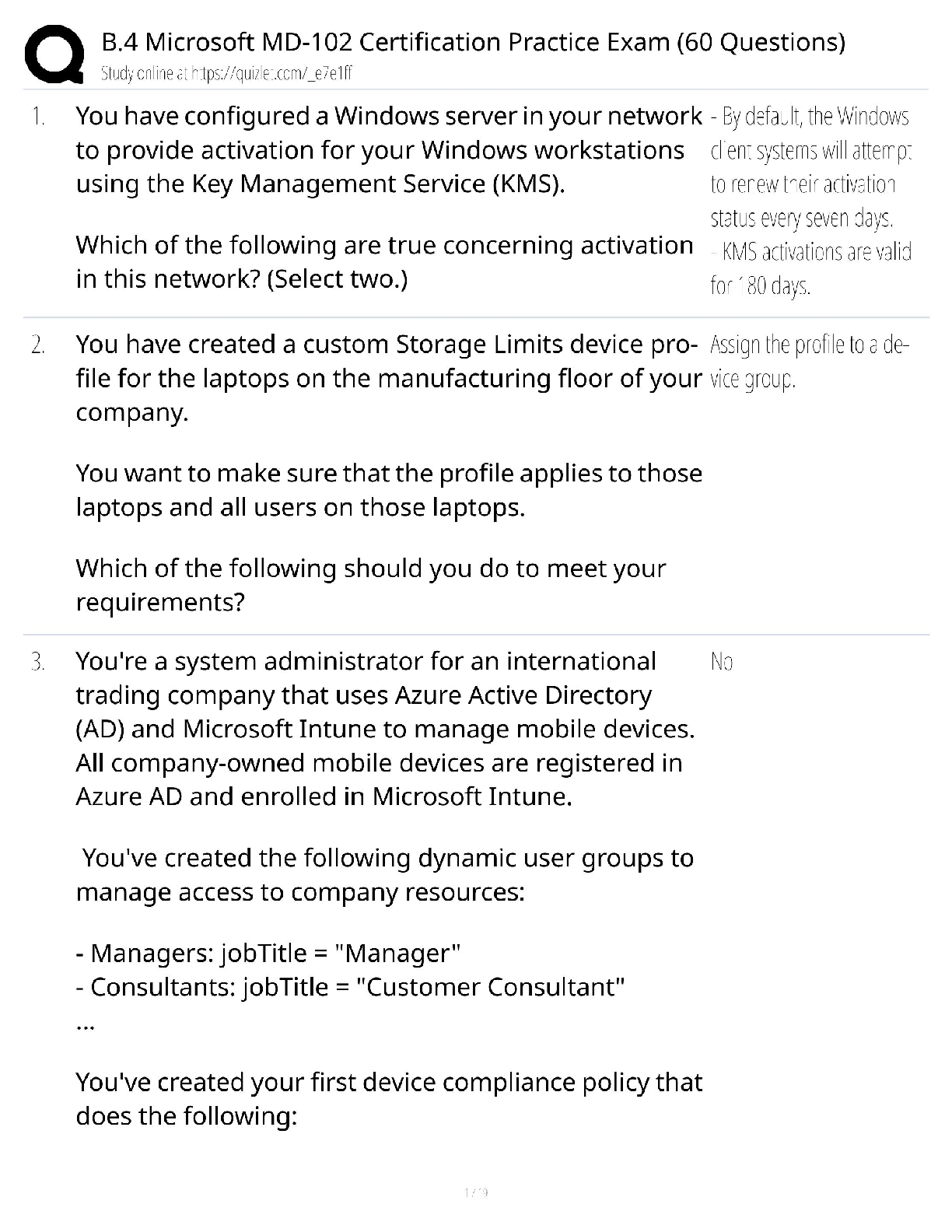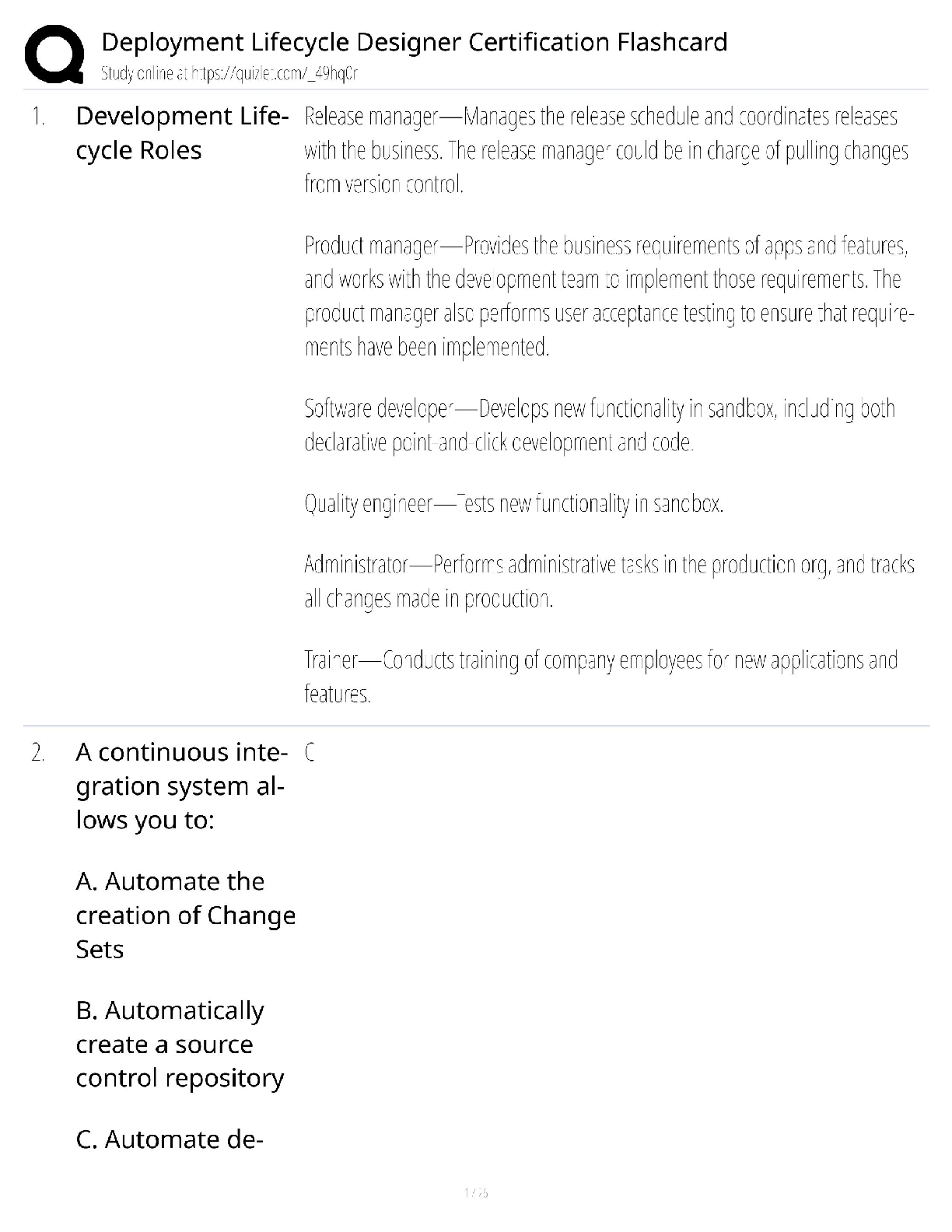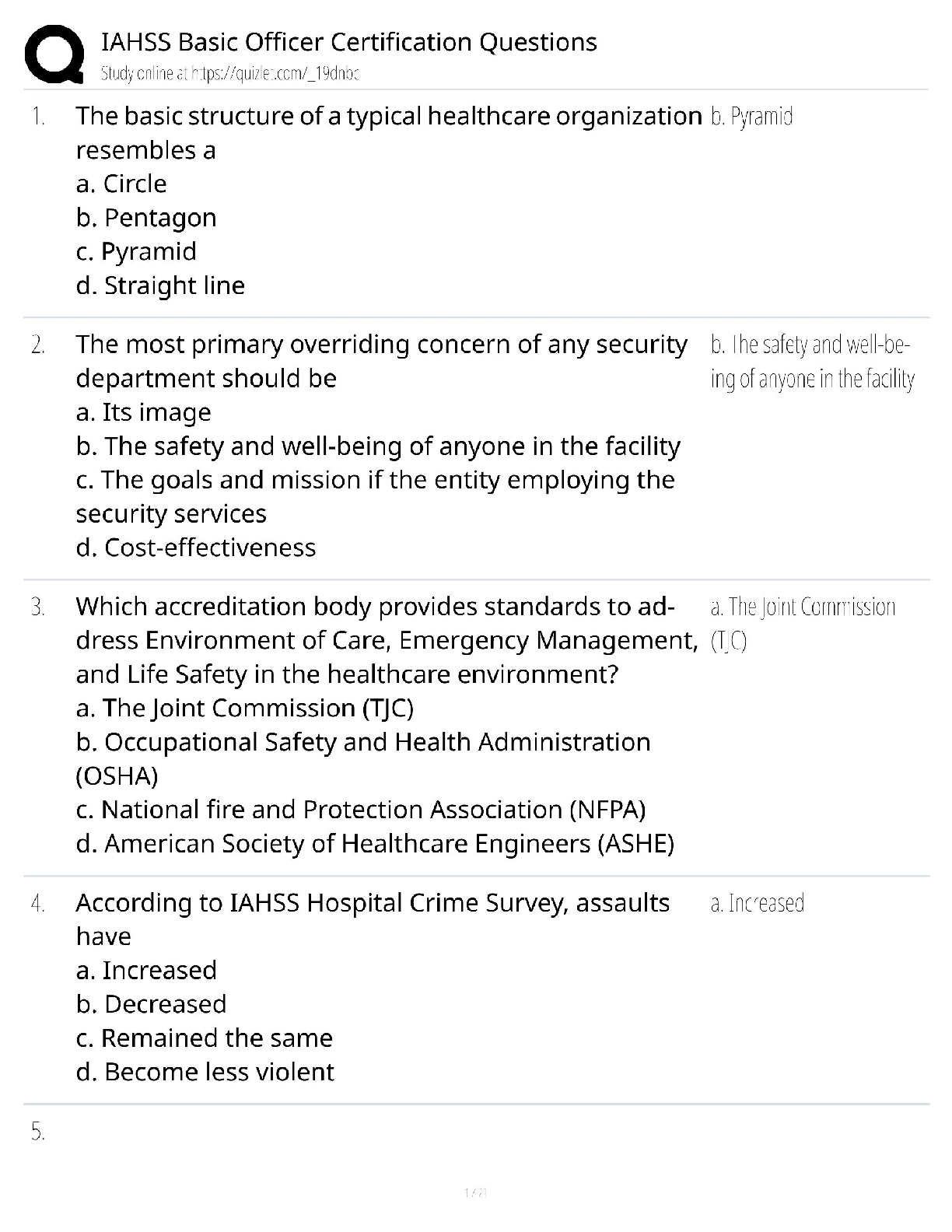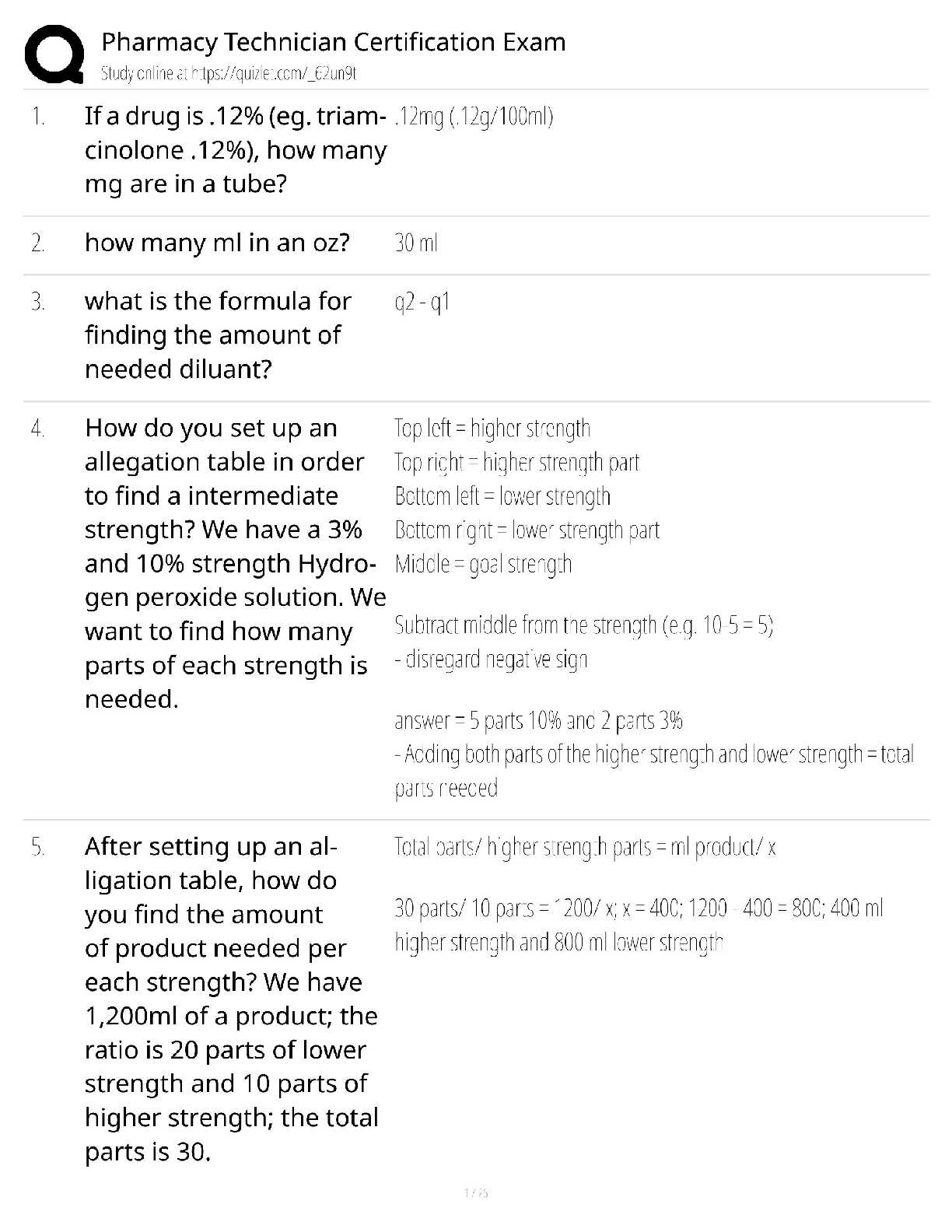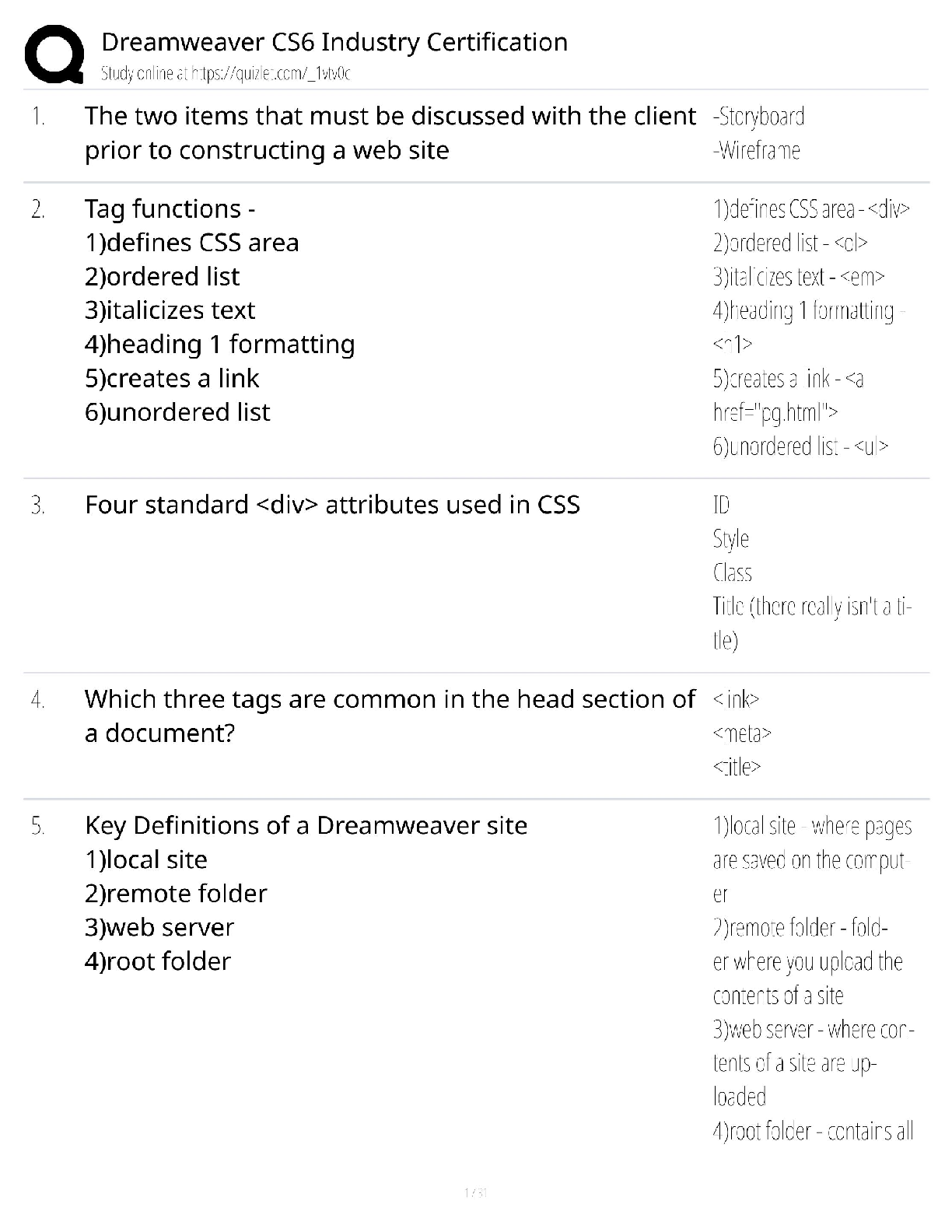*NURSING > QUESTIONS & ANSWERS > ADVANCED NURSING PRACTICE NSG 6001 Respiratory Problems practice question and answers solution docs (All)
ADVANCED NURSING PRACTICE NSG 6001 Respiratory Problems practice question and answers solution docs 100% points
Document Content and Description Below
ADVANCED NURSING PRACTICE NSG 6001 Respiratory Problems practice question and answers solution docs 100% points MULTIPLE CHOICE 1. A chronic cough lasts longer than: A. 3 weeks B. 8 weeks ... C. 6 months D. 1 year 2. You are doing a cerumen extraction and touch the external meatus of your patient’s ear. He winces and starts coughing. What is the name of this reflex? A. Baker phenomenon B. Arnold reflex C. Cough reflex D. Tragus reflex 3. Based on these patients’ histories, which of the following should receive fungal serology testing for their chronic cough? A. A patient with a history of sickle cell disease B. A patient with a history of multiple sclerosis C. A patient with a history of celiac disease D. A patient with a history of AIDS 4. Which of these patients should be given a decongestant? A. Gerta, a 41-year-old female with GERD B. Christine, a 15-year-old female with pneumonia C. Dan, a 60-year-old male with allergic rhinitis D. Andy, a 26-year-old with cystic fibrosis 5. Which of the following herbal supplements should be used cautiously in a patient with hypertension? A. Licorice B. Horehound C. Peppermint D. Jasmine 6. A patient with hypertension comes in and insists that one of his new medications is causing him to cough. When looking at his list of medications, you think the cough must be from: A. Metoprolol B. Clopidogrel C. Tadalafil D. Captopril 7. Lisa is a 25-year-old Hispanic female experiencing chest tightness, a feeling of suffocation, and feels like she “can’t get air in.” She has no current history of heart or lung disease and did not exercise leading up to this attack. Which of the following is the most likely cause for this dyspnea? A. Severe chronic anemia B. Congestive heart failure C. Anxiety-related dyspnea D. Chronic obstructive pulmonary disease (COPD) 8. Which of the following scales is useful to assess the degree of dyspnea with a score of 6 to 20? A. Borg scale B. Patient Health Questionnaire-9 scale C. Visual analog scale D. Global assessment of functioning scale 9. Annie is a 30-year-old African American woman that complains of “coughing up blood.” What is a likely cause of her condition? A. Bronchogenic carcinoma B. Pulmonary embolus with infarction C. Mitral stenosis D. Bronchitis 10. African American patients seem to have a negative reaction to which of the following asthma medications? A. Inhaled corticosteroids B. Long-term beta-agonist bronchodilators C. Leukotriene-receptor agonists D. Oral corticosteroids 11. Sam, age 78, presents to the clinic with respiratory symptoms. His pulmonary function tests are as follows: a normal total lung capacity, a decreased PaO2, and an increased PaCO2. On assessment, you auscultate coarse crackles and forced expiratory wheezes. What is your diagnosis? A. Asthma B. Emphysema C. Chronic bronchitis D. Influenza 12. You are using the CURB-65 clinical prediction tool to decide whether Latisha, whom you have diagnosed with community-acquired pneumonia (CAP), should be hospitalized or treated at home. Which of the following risk factors would increase Latisha’s chance of CAP-associated mortality and complications? A. Temperature of 100F B. Respiratory rate 22 breaths per minute C. Hemoglobin 9.5 g/dL D. History of diabetes mellitus 13. Fredericka is a 40-year-old Hispanic female with a history of diabetes mellitus, hypertension, and HIV. She has a tuberculosis (TB) skin test. What is the smallest diameter of induration that would indicate a positive result? A. 2 mm B. 5 mm C. 8 mm D. 10 mm 14. Why do you suspect that your patient may have a decreased response to the tuberculin skin test (TST)? A. She is on a high-protein diet. B. She is an adolescent. C. She has been on a long-term corticosteroid therapy. D. She just got over a cold. 15. Marci has been started on a TB regimen. Because isoniazid (INH) may cause peripheral neuropathy, you consider ordering which of the following drugs prophylactically? A. Pyridoxine B. Thiamine C. Probiotic D. Phytonadione 16. Which of the following patients is most likely to have squamous cell carcinoma? A. Janice, a 70-year-old female and is a nonsmoker B. Bill, a 65-year-old male with a 20-year history of smoking C. Sophie, a 30-year-old female with a family history of lung cancer D. David, a 90-year-old man whose brother passed away from lung cancer 17. Amy has a history of lung cancer and is experiencing new-onset right side ptosis and miosis and says, “I’m so hot, but I’m not sweating.” Which of the following conditions can be attributed to her new-onset symptoms? A. Bell’s palsy B. Turner’s syndrome C. Murphy’s syndrome D. Horner’s syndrome 18. Jolene has breast cancer that has been staged as T1, N0, M0. What might this mean? A. The tumor size cannot be evaluated; the cancer has not spread to the lymph nodes; and the distant spread cannot be evaluated. B. The cancer is in situ; it is spreading into the lymph nodes but the spread cannot be evaluated otherwise. C. The cancer is less than 3 cm in size and has not spread to the lymph nodes or other parts of the body. D. The cancer is about 5 cm in size; nearby lymph nodes cannot be evaluated; and there is no evidence of distant spreading. 19. Nathan, a 32-year-old policeman, has a 15-pack-a-year history of smoking and continues to smoke heavily. During every visit, he gets irate when you try to talk to him about quitting. What should you do? A. Hand him literature about smoking cessation at every visit. B. Wait until he is ready to talk to you about quitting. C. Document in the record that he is not ready to quit. D. Continue to ask him at every visit if he is ready to quit. 20. Your patient has decided to try to quit smoking with Chantix. You are discussing his quit date, and he will begin taking the medicine tomorrow. When should he plan to quit smoking? A. He should stop smoking today. B. He should stop smoking tomorrow. C. His quit date should be in 1 week. D. He will be ready to quit after the first 30 days. 21. Which information should be included when you are teaching your patient about the use of nicotine gum? A. The gum must be correctly chewed to a softened state and then placed in the buccal mucosa. B. Patients should not eat for 30 minutes prior to or during the use of the gum. C. Initially, 1 piece is chewed every 30 minutes while awake. D. Acidic foods and beverages should be encouraged during nicotine therapy. 22. Which of these sputum strains would one use to test for a viral respiratory culture? A. Gram stain B. Direct fluorescent antibody stain C. Wright-Giemsa stain D. Acid-fast stain 23. What is the first-line recommended treatment against Group A beta-hemolytic streptococci (GABHS), the most common cause of bacterial pharyngitis? A. Penicillin B. Quinolone C. Cephalosporin D. Macrolide 24. Cydney presents with a history of asthma. She has not been treated for a while. She complains of daily but not continual symptoms, greater than 1 week and at nighttime. She has been using her rescue inhaler. Her FEV1 is 60% to 80% predicted. How would you classify her asthma severity? A. Mild intermittent B. Mild persistent C. Moderate persistent D. Severe persistent 25. Joyce is taking a long-acting beta agonist for her asthma. What additional medication should she be taking? A. Inhaled corticosteroid B. Leukotriene-receptor antagonist C. Systemic corticosteroid D. Methylxanthines 26. Your patient is on theophylline for his asthma. You want to maintain his serum levels between: A. 0 to 5 mcg/mL B. 5 to 10 mcg/mL C. 5 to 15 mcg/mL D. 10 to 20 mcg/mL 27. George has COPD and an 80% forced expiratory volume in 1 second. How would you classify the severity of his COPD? A. Stage 1 mild COPD B. Stage 2 moderate COPD C. Stage 3 severe COPD D. Stage 5 very severe COPD 28. Most nosocomial pneumonias are caused by: A. Fungi B. Viruses C. Gram-negative bacteria D. Pneumococcal pneumonia 29. Which of the following statements regarding TST is true? A. Tests should be read 48 hours after the injection. B. The size of the TST reaction has nothing to do with erythema but is based solely on induration. C. It is a type V T-cell-mediated immune response. D. The diameter of the induration is measured in centimeters. 30. Which obstructive lung disease is classified as reversible? A. Asthma B. Chronic bronchitis C. Emphysema D. COPD 31. Which of the following asthma medications should be used cautiously with geriatric patients? A. Atrovent B. Ventolin C. Singulair D. Asmanex 32. Which statement about adenocarcinoma of the lung is accurate? A. It is the least common type of lung cancer, representing approximately 5% to 10% of cases. B. It is the most prevalent carcinoma of the lungs in both sexes and in nonsmokers, representing 35% to 40% of all tumors. C. It is more common in men than in women and occurs almost entirely in cigarette smokers. D. It is aggressive, with rapid growth in primarily the liver and brain. 33. Jason, age 62, has obstructive sleep apnea. What do you think is one of his contributing factors? A. He is a recovering alcoholic of 6 years. B. His collar size is 17 inches. C. He is the only person in his family who has this. D. He is extremely thin. 34. What is the pressure needed for continuous positive air pressure (CPAP) to abolish apneas, snoring, and oxyhemoglobin desaturations in all positions and during REM sleep? A. 5 to 20 cm H2O B. 10 to 25 cm H2O C. 15 to 25 cm H2O D. 20 to 35 cm H2O 35. What is a procedure that can be performed in the outpatient setting for a patient with obstructive sleep apnea? A. Mandibular advancement B. Laser-assisted uvulopalatoplasty C. Retroglossal obstruction removal D. Uvulopalatopharyngoplasty 36. Tina is a 3-week-old who was recently diagnosed with influenza. Which of the following medications would be appropriate to treat her condition? A. Liquid oseltamivir B. Inhaled zanamivir C. Inhaled oseltamivir D. Liquid zanamivir 37. The forced vital capacity is decreased in: A. Asthma B. Chronic bronchitis C. Emphysema D. Restrictive disease 38. What is the most common cause of CAP? A. Streptococcus pneumoniae B. Klebsiella pneumoniae C. Legionella pneumoniae D. Pseudomonas aeruginosa 39. Which of the following patients would you expect to have a decreased response to TST? A. Julie, a 50-year-old postal worker with hypertension B. Sandy, a 40-year-old patient who recently survived a fire that left 40% of her total body surface covered in burns C. Jill, a 16-year-old cheerleader with type 1 diabetes D. Mark, a 29-year-old tennis player who currently has a cold 40. Which of the following is a possible consequence of sleep apnea? A. Asthma B. Increased white blood cells C. Insulin resistance D. Hyperactivity 41. Which of the following conditions is associated with cigarette smoking? A. Glaucoma B. Increased sperm quality C. Bladder cancer D. Eczema 42. Marta is taking TB drugs prophylactically. How do you instruct her to take them? A. Take them on an empty stomach to facilitate absorption. B. Take them with aspirin (ASA) to prevent flushing. C. Take them with ibuprofen to prevent a headache. D. Take them with food to prevent nausea. 43. Which of the following statements regarding pulmonary function and cigarette smoking is true? A. Cigarette smoking causes an increase in circulating immunoglobulin levels. B. Cigarette smoking has no increased risk of COPD. C. Cigarette smoking decreases mucus production. D. Cigarette smoking increases the risk of pneumothorax. 44. How much nicotine does an average cigarette contain? A. 5 to 10 mg B. 10 to 15 mg C. 15 to 20 mg D. 20 to 25 mg 45. Madeline is a smoker in a primary-care visit with her provider. After her provider asks if she is willing to quit, she says she has decided to quit, has bought nicotine gum, and is interested in hearing about Chantix. Which of the following steps is Madeline in regarding behavioral changes and her attempts at cessation? A. Precontemplation B. Action C. Maintenance D. Preparation 46. Eleanor would like to quit smoking, but she is unsure of the benefits, as she is 60 years old. Which of these is a benefit to quitting smoking that her provider should inform her of? A. Enhanced taste and smell B. Improved hearing C. Decreased risk of diabetes mellitus D. Decreased risk of sexually transmitted diseases 47. The barrel-chest characteristic of emphysema is a result of: A. Chronic coughing B. Hyperinflation C. Polycythemia D. Pulmonary hypertension 48. Supplemental oxygen for how many hours per day has been shown to improve the mortality associated with COPD? A. 3 hours B. 6 hours C. 11 hours D. 15 hours 49. Which of these patients should be evaluated with serum alpha-antitrypsin levels? A. Jamie, a 70-year-old female with COPD with a history of smoking B. Ron, a 43-year-old male with COPD with a history of smoking C. Leslie, a 60-year-old female with clinical emphysema and no history of smoking D. Marshall, a 55-year-old male with clinical emphysema and no family history of early-onset COPD 50. Which ethnic group has the highest lung-cancer incidence and mortality rates? A. African American men B. Scandinavian men and women C. Caucasian women D. Asian men [Show More]
Last updated: 3 years ago
Preview 1 out of 9 pages
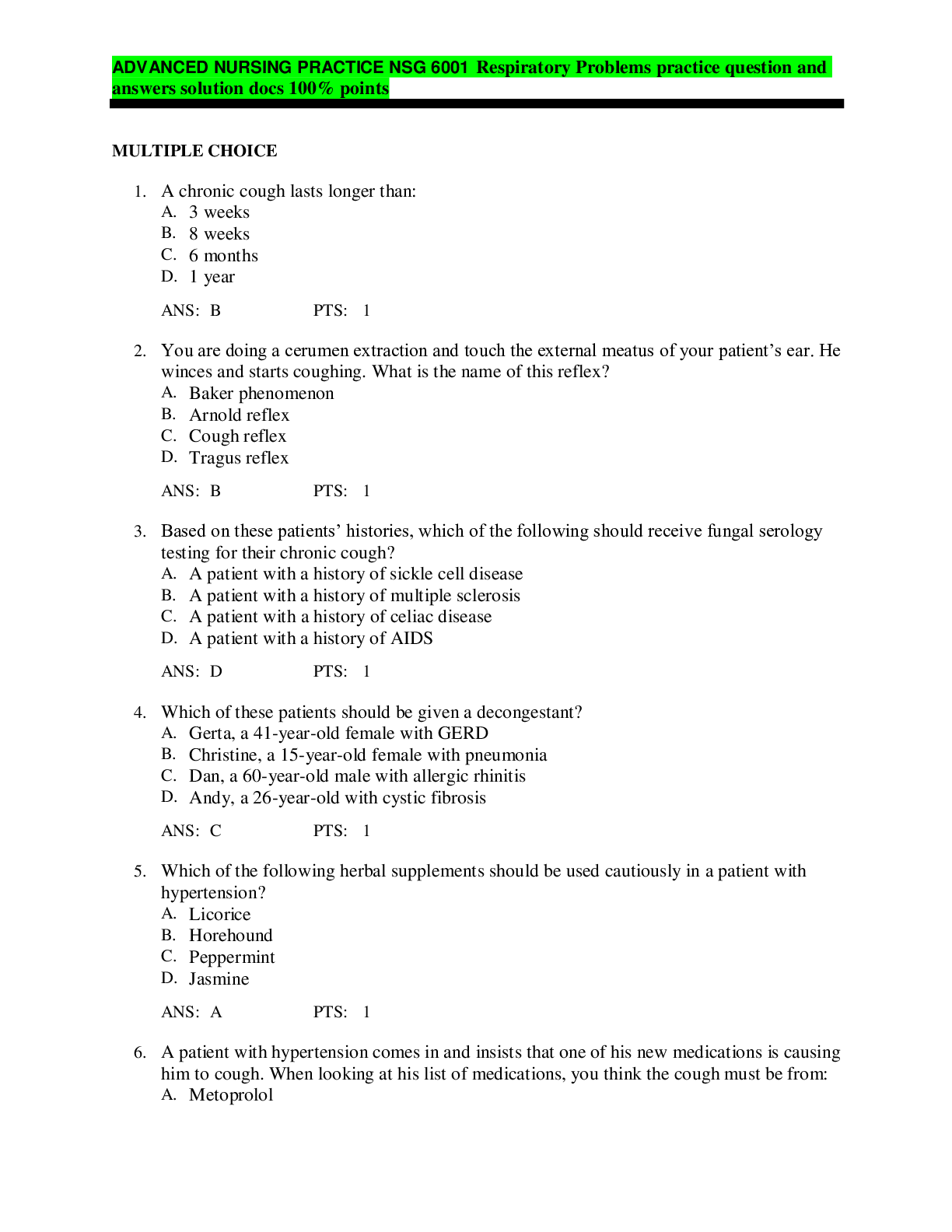
Buy this document to get the full access instantly
Instant Download Access after purchase
Buy NowInstant download
We Accept:

Reviews( 0 )
$12.50
Can't find what you want? Try our AI powered Search
Document information
Connected school, study & course
About the document
Uploaded On
Dec 03, 2020
Number of pages
9
Written in
All
Additional information
This document has been written for:
Uploaded
Dec 03, 2020
Downloads
0
Views
123

 answers.png)












